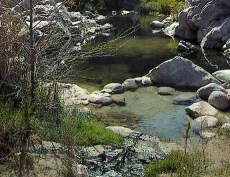National forest in crisis, expert says
PROTECTION: The measures being taken do not address long-term threats, a professor notes.
05/01/2003
By BEN GOAD
THE PRESS-ENTERPRISE
It will take global perspective, with an eye toward history and an acceptance of modern ideas, to save the overly dense, parched and beetle-ridden San Bernardino National Forest, a visiting expert said Wednesday.
For more than a year, local officials have pleaded for public funds and frantically
formulated plans, focusing on the risk of catastrophic wildfires now facing the forest and its mountain communities.
While necessary to preserve public safety, these measures do not address the long-term threats facing the forest, which has changed drastically over the past century, said Thomas Bonnicksen of the Forest Foundation.
Natural forest regime
Bonnicksen, a Texas A&M professor with a doctorate in forest policy from UC Berkeley, toured the forest this week with a small group of other experts and has spoken at length with several citizen-run activist groups.
"We've got to deal with the current crisis, but my concern is the forest itself," Bonnicksen said. "There is nothing more sustainable, nothing that is superior to the natural forest regime. We have to try to get back, as close as we can, to that natural forest regime."
Under natural conditions, minor wildfires serve to thin the forest every five to 18 years, Bonnicksen said. Trees grow in patches, which form a mosaic of old and young trees of different species.
Native Americans in Southern California up through the 19th century were apt users of fire to manage the forest, he said. Bonnicksen said fully half of the fires in those times were started by area tribes to clear underbrush and promote plant growth for foraging deer and elk.
When settlers arrived in the Inland area, the natural ebb and flow of trees in the forest was forever altered. The Native Americans were pushed out, and a century of fire suppression followed, resulting in an overgrown forest where trees must fight for water.
Now, in the fifth year of a drought that may last for two decades, an onslaught of bark beetles has left more than a million trees dead.
County and state emergency declarations have galvanized forest and fire officials,
who now are urging President Bush to declare a national emergency and
designate hundreds of millions of dollars for removal of the dead trees.
Healthy restoration
Bonnicksen said he wants to look past that stage and begin planning for the restoration of a thinned, healthy forest. He said areas with living pines need to be cut and, years later, re-cut so the new forest will include swathes of forest with trees of diverse sizes, ages and species.
He promoted the use of vehicles with lawnmowerlike revolving blades that are already being used in other areas of the nation to clear brush, rather than relying solely on prescribed burns.
"I don't care if we use lasers or ray guns -- it's not the tool I'm interested in," he said. "There's no way in hell anyone is going to sustain this forest with just fire ever again."
His colleague, Phillip Aune of the California Forestry Association, added that a stand-alone biological-mass energy plant could by constructed in Idyllwild or Lake Arrowhead. That way, Aune said, the waste from the thinning that is without market value could be used to provide power to the mountain communities.
This approach, while scientifically sound, may not be economically feasible, said Jon Regelbrugge, an ecologist with the U.S. Forest Service.
"When you trim the forest, trying to make it look how you want, the value of what you take out will cut only a fraction of the cost of the tree removal," he said. "If you can gain societal understanding and support, however, the funding might take care of itself."
Ben Goad can reached by email at bgoad@pe.com.
Forest in Crisis
All posts are those of the individual authors and the owner
of this site does not endorse them. Content should be considered opinion
and not fact until verified independently.
| Subject | Author | Views | Posted |
|---|---|---|---|
| katrina island | 1226 | May 04, 2003 12:09PM | |
| LaughingBear | 678 | May 07, 2003 07:18AM | |
| Free our Forests | 684 | May 07, 2003 10:59AM | |
| LaughingBear | 752 | May 07, 2003 05:17PM | |
| eastbay | 683 | May 08, 2003 11:30AM | |
| LaughingBear | 660 | May 08, 2003 08:31PM | |
| eastbay | 696 | May 09, 2003 12:50PM | |
| LaughingBear | 1187 | May 09, 2003 10:14PM |
Sorry, only registered users may post in this forum.




